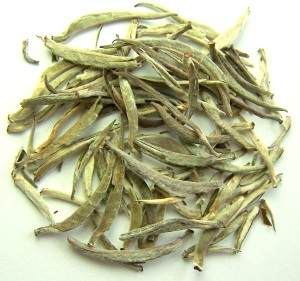Once the purview of only the Chinese elite, white tea has become popular across a wide spectrum of tea drinkers. It is now gaining a following in the West as a healthy and unique variety of tea. With the higher echelons of white teas fetching some of the best price margins in the business, many analysts expect white tea to be a viable category for some time to come.
Silver Needles and White Peony
White tea was originally developed in China. It was originally consumed by wealthy Chinese officials or businessmen. With the waxing and waning of tea consumption trends over the last few hundred years demand for white tea has likewise risen and fallen. Originally, white tea was only made from the unoxidized nascent buds of the Camellia sinensis plant. These “silver needles” were appreciated for their nuanced flavor and fine white downy hairs which gave rise to the name “white tea.”
In the early 20th century entrepreneurial tea growers started plucking the next two leaves in addition to the bud and processing them the same way as the silver needles by drying and withering the leaves over modest heat but not subjecting them to pan firing or steaming in order to stop the enzymes from continuing to oxidize the tea. This creation became known as white peony or Bai Mu Dan.
What is White Tea Exactly?
There are many other sub varieties of white tea, most of them variations of silver needles or white peony. There is also some confusion about how white teas are defined. Some producers in China refuse to recognize anything as white tea except silver needles produced from a certain cultivar. For practical purposes in the North American market, however, most industry representatives categorize white tea by processing methods rather than cultivar. A white tea is one that is plucked, withered, and dried without an additional intense heating step meant to arrest oxidation.
Flavor, Liquor, and Caffeine
Generally speaking, white teas tend to have lighter, yellower liquors than other styles of tea. The flavors can be quite light depending on the strategy used for steeping. We generally recommend 2 grams per 6oz of water at 208 degrees for 3-5 minutes. As we wrote previously about black teas, there is also a common misconception about the caffeine content of white tea. In spite of its light flavor and liquor white tea does, in fact, have some caffeine. Generally speaking, you can expect most teas to have about a third of the caffeine you would find in a cup of coffee. The exact amount of caffeine is determined by the amount of tea used, the temperature, and the steeping time.
Contact us for more information or to place an order for white teas.
What do you think? What is the best white tea you’ve tasted? Leave us a comment below!






Leave us a Comment